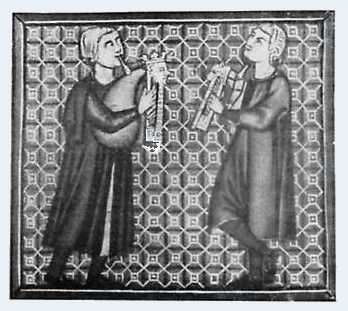Cantigas de Santa Maria / Falsobordone
attributed to Alfonso X., 1221—1284

medieval.org
Acantha acacd 0042
1998
1. (4:19)
Nas mentes sempre ter [2:31]
CSM 29
Null'ome per ren non deve [1:48]
CSM 361
bagpipe, symphonie, voice, darbukka
2. Como poden per sas culpas [5:02]
CSM 166
harp, rebec, voice
3. Par deus, muit' á gran vertude [3:11]
CSM 282
bagpipes, long drum, darbukka
4. Santa Maria amar [4:51]
CSM 7
harp, voice
5. (3:32)
Pois las figuras [2:09]
CSM 136
Santa Maria loei et loo [1:23]
CSM 200
recorders, rebec, vasija, darbukka
6. (7:03)
Santa Maria, strela do dia [4:38]
CSM 100
U alguen a Jhesu Cristo [2:25]
CSM 281
harp, voice, rebec, percussion
7. Gran poder á de mandar [3:42]
CSM 33
harp
8. Des oge mais quer eu trobar [5:46]
CSM 1
harp, voices, rebec, recorder
9. Non sofre Santa Maria [2:23]
CSM 159
bagpipe, vasija
10. A Virgen, que de Deus Madre [4:27]
CSM 322
harp, voices
11. Maravillosos e piadosos [4:58]
CSM 139
harp, psaltery
12. (4:16)
A Virgen mui groriosa [1:25]
CSM 42
Quen quer que na Virgen fia [2:51]
CSM 167
shawm, bagpipes, long drum, darbukka
All arrangements by Falsobordone

Falsobordone
consist of
Anna Rynefors & Erik Ask-Upmark
and was reinforced during the making of this CD by Anders Ådin on percussion.
Our goal is to perform medieval music as authentically as possible,
without reducing it to a museum piece.
We want to show that music, centuries old,
still can be most vital and tell us something, if we will just listen...
We would be happy to play at just your castle,
living history event, medieval market, festival...
Many different musical programs can be offered,
ranging from the Viking age through the early Baroque.

About the Cantigas de Santa María
Once
upon a time there was a king called Alfonso X, who ruled over Castille,
Toledo and León. He was known as “el sabio” - the wise, and being so
clever he realized that he probably should do something in his life,
besides being king, to ensure that he would go to heaven. No lady has
ever been able to resist a good serenade, he thought, and so started to
write (or ordered his scribes and scholars to write) a collection of
songs devoted to the Virgin Mary. He called it Las Cantigas de Santa
Maria.
Today, four copies of this collection remains (dating from
the late thirteenth to early fourteenth century). The most complete of
them contains 423 cantigas. The texts are mostly about miracles
performed by the Virgin (Cantiga de miragres), but every tenth text is a
hymn to praise her (Cantiga de loor) and has a beautiful illustration,
usually of Alfonso and his court or of musicians and their instruments.
The
melodies are much similar to the troubadour and trouvere music of the
time, and it is very probable that Alfonso and his assistants borrowed a
lot of the melodies from common secular songs of the day.

In
the Cantigas manuscripts, there are plenty of illustrations showing
merry musicians playing away. These pictures are of course a great help
in deciding what instruments to use when reconstructing the music of
13th century Spain.
Instrument makers
rebec (AR) — James Bisgood 1994, London
symphonie (AR) — Allan Fagerlund 1997, Gothenburg
harps (EAU, AR) — Johan Hedvall 1997, Gothenburg
bagpipes (EAU, AR) — Alban Faust 1988 & 1993, Frestersbyn
— Jim Parr 1998, Norwich
psaltery (EAU) — anon., Wales
recorder (EAU) — Kobliczek, 1996 Germany
— Camac 1984, France
shawm (EAU) — Eric Moulder 1996, Leek
medieval long drum (AÅ) — Per-Olof Martineson 1995, Gothenburg
darbukka (AÅ) — anon.
vasija (AÅ) — anon.
nuts, bells, etc. (AÅ) — anon.

WARNING: Too much shawm-playing can be bad for your health!
Sources
Anglés, Higinio: La Música de las Cantigas de Santa María (Barcelona, 1964)
Facsimile reproduction of the Escorial manuscript.
Anglés, Higinio: La Música de las Cantigas de Santa María (Barcelona, 1943)
Transcription and critical study of the same manuscript.
Mettmann, Walter: Cantigas de Santa Maria vol I - III (Coimbra, 1959, 1961, 1964)
Complete texts.
Recorded in the church of Tidersrum, Östergötland 1998-04-20 - 1998-04-22.
This church is somewhat unique, being a preserved wooden church front the late thirteenth century
- in other words, from the same time as the Cantigas!
CD booklet texts: Falsobordone
Layout & Design: Falsobordone & Hans Edgren
German translation: Thomas Meyer
Producer: Kulturkometen, Gothenburg
Photos: Johan Hedvall 1998 & Thomas Wegebrand 1997
CD manufactured by: Logo, Gothenburg
Sound technician & mastering: Niklas Rönnberg
Thanks to:
Lars Tallund for letting us borrow the church;
Hans Edgren for helping us (to say the least) with the booklet;
Ingrid Rynefors, P-O, Allan, Alban and Johan for lending us some great instruments;
Thomas and Musikbörsen in Linköping fo the use of their studio;
Niklas, for putting up with us once again.






